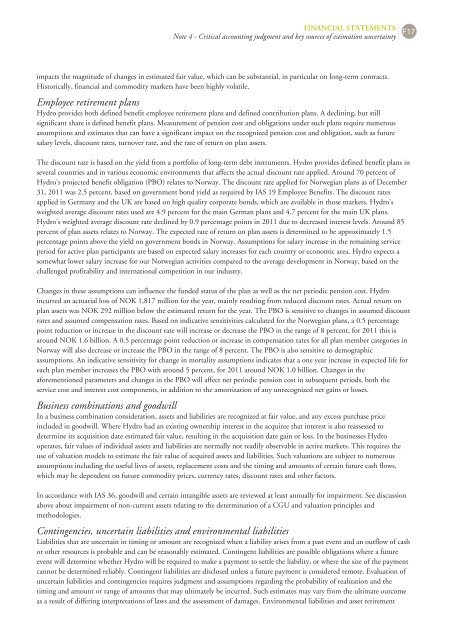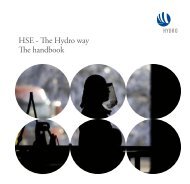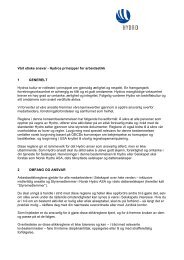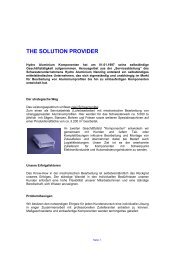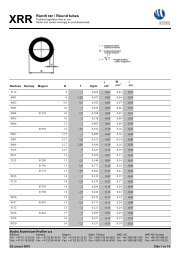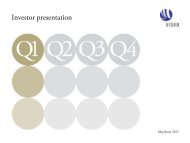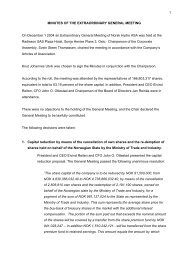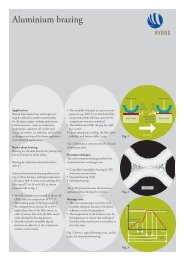Hydro Annual Report 2011b
Hydro Annual Report 2011b
Hydro Annual Report 2011b
Create successful ePaper yourself
Turn your PDF publications into a flip-book with our unique Google optimized e-Paper software.
FINANCIAL STATEMENTS<br />
Note 4 - Critical accounting judgment and key sources of estimation uncertainty F17<br />
impacts the magnitude of changes in estimated fair value, which can be substantial, in particular on long-term contracts.<br />
Historically, financial and commodity markets have been highly volatile.<br />
Employee retirement plans<br />
<strong>Hydro</strong> provides both defined benefit employee retirement plans and defined contribution plans. A declining, but still<br />
significant share is defined benefit plans. Measurement of pension cost and obligations under such plans require numerous<br />
assumptions and estimates that can have a significant impact on the recognized pension cost and obligation, such as future<br />
salary levels, discount rates, turnover rate, and the rate of return on plan assets.<br />
The discount rate is based on the yield from a portfolio of long-term debt instruments. <strong>Hydro</strong> provides defined benefit plans in<br />
several countries and in various economic environments that affects the actual discount rate applied. Around 70 percent of<br />
<strong>Hydro</strong>'s projected benefit obligation (PBO) relates to Norway. The discount rate applied for Norwegian plans as of December<br />
31, 2011 was 2.5 percent, based on government bond yield as required by IAS 19 Employee Benefits. The discount rates<br />
applied in Germany and the UK are based on high quality corporate bonds, which are available in those markets. <strong>Hydro</strong>'s<br />
weighted average discount rates used are 4.9 percent for the main German plans and 4.7 percent for the main UK plans.<br />
<strong>Hydro</strong>'s weighted average discount rate declined by 0.9 percentage points in 2011 due to decreased interest levels. Around 85<br />
percent of plan assets relates to Norway. The expected rate of return on plan assets is determined to be approximately 1.5<br />
percentage points above the yield on government bonds in Norway. Assumptions for salary increase in the remaining service<br />
period for active plan participants are based on expected salary increases for each country or economic area. <strong>Hydro</strong> expects a<br />
somewhat lower salary increase for our Norwegian activities compared to the average development in Norway, based on the<br />
challenged profitability and international competition in our industry.<br />
Changes in these assumptions can influence the funded status of the plan as well as the net periodic pension cost. <strong>Hydro</strong><br />
incurred an actuarial loss of NOK 1,817 million for the year, mainly resulting from reduced discount rates. Actual return on<br />
plan assets was NOK 292 million below the estimated return for the year. The PBO is sensitive to changes in assumed discount<br />
rates and assumed compensation rates. Based on indicative sensitivities calculated for the Norwegian plans, a 0.5 percentage<br />
point reduction or increase in the discount rate will increase or decrease the PBO in the range of 8 percent, for 2011 this is<br />
around NOK 1.6 billion. A 0.5 percentage point reduction or increase in compensation rates for all plan member categories in<br />
Norway will also decrease or increase the PBO in the range of 8 percent. The PBO is also sensitive to demographic<br />
assumptions. An indicative sensitivity for change in mortality assumptions indicates that a one year increase in expected life for<br />
each plan member increases the PBO with around 5 percent, for 2011 around NOK 1.0 billion. Changes in the<br />
aforementioned parameters and changes in the PBO will affect net periodic pension cost in subsequent periods, both the<br />
service cost and interest cost components, in addition to the amortization of any unrecognized net gains or losses.<br />
Business combinations and goodwill<br />
In a business combination consideration, assets and liabilities are recognized at fair value, and any excess purchase price<br />
included in goodwill. Where <strong>Hydro</strong> had an existing ownership interest in the acquiree that interest is also reassessed to<br />
determine its acquisition date estimated fair value, resulting in the acquisition date gain or loss. In the businesses <strong>Hydro</strong><br />
operates, fair values of individual assets and liabilities are normally not readily observable in active markets. This requires the<br />
use of valuation models to estimate the fair value of acquired assets and liabilities. Such valuations are subject to numerous<br />
assumptions including the useful lives of assets, replacement costs and the timing and amounts of certain future cash flows,<br />
which may be dependent on future commodity prices, currency rates, discount rates and other factors.<br />
In accordance with IAS 36, goodwill and certain intangible assets are reviewed at least annually for impairment. See discussion<br />
above about impairment of non-current assets relating to the determination of a CGU and valuation principles and<br />
methodologies.<br />
Contingencies, uncertain liabilities and environmental liabilities<br />
Liabilities that are uncertain in timing or amount are recognized when a liability arises from a past event and an outflow of cash<br />
or other resources is probable and can be reasonably estimated. Contingent liabilities are possible obligations where a future<br />
event will determine whether <strong>Hydro</strong> will be required to make a payment to settle the liability, or where the size of the payment<br />
cannot be determined reliably. Contingent liabilities are disclosed unless a future payment is considered remote. Evaluation of<br />
uncertain liabilities and contingencies requires judgment and assumptions regarding the probability of realization and the<br />
timing and amount or range of amounts that may ultimately be incurred. Such estimates may vary from the ultimate outcome<br />
as a result of differing interpretations of laws and the assessment of damages. Environmental liabilities and asset retirement


